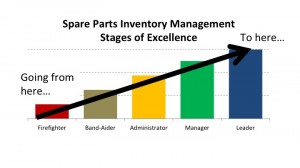
When going through their budgeting process it is common for companies to set new spare parts inventory goals for the year or to at least review their existing goals.
However, when they do this many companies are setting themselves up for failure.
Let me explain that.
Spare Parts Inventory Goals Must Be Attached to Logical Actions
The reason that companies are setting themselves up for failure is that they either don’t know about or perhaps ignore the one step that you MUST take if you want to achieve your spare parts inventory goals.
That step is this: Identify the assumptions that are being made about how your actions will lead to the end goal.
Let’s say that a company sets a goal to reduce their inventory by 10% by the end of their financial year.
This is a worthwhile inventory management goal and no doubt will get the attention of senior management.
But actions based on incorrect assumptions are unlikely to achieve the goal.
You need to be explicit about both the actions that the company will take and the associated assumptions and how they lead to the goal.
But that is not today’s tip.
Today’s tip: Identify why you cannot currently achieve your goal.
The problem is NOT that there is too much inventory. Or the wrong mix of inventory.
These outcomes are the result of something else within your spare parts management approach.
The problem lies somewhere within the decision-making or management process that determine the items that you buy and the level of stock that you hold.
The problem could be to do with the management (or lack of management) with obsolescence and disposal.
The problem could be to do with poor discipline in the application of policy and process.
No matter what your specific problem, the key to achieving your goals is too first identify and define why you cannot achieve your goal today.
The correct problem definition enables you to focus your actions
Try these steps
Try these steps to ensure that there is a logical fit between the goal and the proposed solution:
- Describe the outcome that you are trying to achieve – for example, reduce inventory by 10%. This is the goal.
- Identify why you currently can’t achieve that goal – i.e what’s missing or being done incorrectly. This is the gap.
- Define the actions that you are planning to implement to address the gap.
- Use an “if-this-then-that” analysis to identify how the actions or activities you are planning will close the gap and lead to your goal.
- Check the assumptions that you are making – are they logical and will the result of those actions close the gap and contribute to your goal?
By using this approach you will ensure the logical connection between your planned actions, the gap and the goal.
You might also be interested in a post on Inventory management goals.
Joining our Pro Level gives you access to the resources you need to identify and implement the required actions.
For information on our Pro Level membership please visit our Pro Level page.
Posted by: Phillip Slater